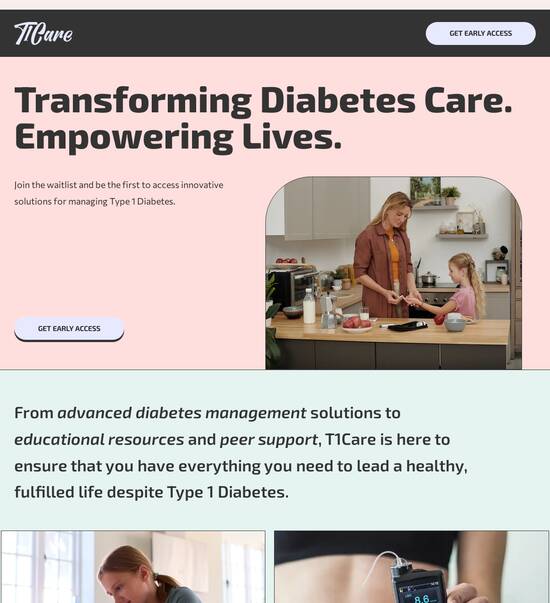
Government website template compatible with Drupal
Explore Similar TemplatesAbout template
Streamline your content management with government website templates designed for compatibility with Drupal.
Recommended templates

Easy to build without coding
With the intuitive drag-and-drop builder, anyone on your team can create high-converting pages without any knowledge of code or design. Make enhancements to your landing page with custom widgets using Javascript, HTML/CSS, or third-party scripts.

Multiple layouts for any industry and goal
Select from 500+ landing page layouts built to boost conversions across industry-specific scenarios. Customize them by adjusting fonts, adding images, and generating on-brand content with the AI assistant. Quickly scale with Instablocks® and Global Blocks that you can save, reuse, and update globally.

Loads fast and looks polished on any device
Every template is responsive, which means they present professionally on any device and load blazingly fast with our Thor Render Engine. You can also power them up with Google AMP technology to deliver an unparalleled mobile experience and drive higher conversions.

Robust analytics & experimentation
Get real-time updates and reporting across all your devices, showing the number of visitors, conversions, cost-per-visitor, and cost-per-lead. Launch AI-powered experiments, run A/B tests, and use heatmaps to analyze user behavior, then optimize your landing page to maximize conversions.







Easy to build without coding
With the intuitive drag-and-drop builder, anyone on your team can create high-converting pages without any knowledge of code or design. Make enhancements to your landing page with custom widgets using Javascript, HTML/CSS, or third-party scripts.
Multiple layouts for any industry and goal
Select from 500+ landing page layouts built to boost conversions across industry-specific scenarios. Customize them by adjusting fonts, adding images, and generating on-brand content with the AI assistant. Quickly scale with Instablocks® and Global Blocks that you can save, reuse, and update globally.
Loads fast and looks polished on any device
Every template is responsive, which means they present professionally on any device and load blazingly fast with our Thor Render Engine.
Robust analytics & experimentation
Get real-time updates and reporting across all your devices, showing the number of visitors, conversions, cost-per-visitor, and cost-per-lead. Launch AI-powered experiments, run A/B tests, and use heatmaps to analyze user behavior, then optimize your landing page to maximize conversions.
All the features you need to build drupal government
Explore more featuresLearn how to build custom government drupal support plans
Frequently asked questions about drupal for government
Leading the way in building high-performing landing pages





Free government website templates: Your ultimate how-to guide
Instapage is not just any platform; it is the definitive solution for marketers aiming to maximize the ROI of their digital marketing campaigns. With over 100 professionally designed, high-converting templates and lead generation elements at your disposal, launching optimized landing pages becomes seamless and effective, specifically tailored for business services, marketing, tech, education, and other vital sectors.
Getting Started with Instapage Landing Pages
Creating powerful landing pages has never been easier. Instapage enables marketers in the USA to construct attractive, conversion-optimized landing pages without requiring developer skills. The user-friendly platform offers a selection of layouts and pre-built components that facilitate rapid page design and lead capture.
- User-friendly interface: Intuitive drag-and-drop functionality makes it easy for marketers of all backgrounds.
- Conversion-focused layouts: 100+ layouts are designed to enhance user engagement and promote action.
- Dedicated customer support: Access to a support team for assistance during the page-building process.
Step 1: Leveraging Optimization Tools
The first step to optimize your landing pages is to utilize Instapage's built-in experimentation features. A/B testing allows you to compare different versions of your landing page, ensuring that you can make data-driven decisions. Furthermore, detailed heatmaps provide insights into how visitors interact with your content.
- A/B testing: This feature helps identify which elements convert better, guiding strategic adjustments.
- Heatmaps: Visualize user interactions and make informed decisions based on engagement.
- Analytics dashboard: Comprehensive insights help assess performance and ROI effectively.
Step 2: Personalizing User Experience
Creating personalized content is paramount for increased engagement. Instapage allows for dynamic text replacement to align your landing page content with your target audience's interests and behaviors. This level of personalization is crucial in enhancing customer experience and driving conversions.
- Dynamic ads: Align specific advertisements with page content, ensuring relevance to visitors.
- Audience tracking: Utilize insights to tailor your landing pages effectively for specific segments.
- Customizable templates: Customize templates to cater to unique call-to-action strategies.
Step 3: Enhancing Collaboration
Collaboration is key to improving your marketing outcomes. Instapage facilitates seamless feedback and page edits among team members. Whether working in-house or with external stakeholders, you can ensure that everyone is on the same page and that feedback is promptly integrated.
The combination of these strategies not only accelerates page production but also enhances the creativity and effectiveness of your marketing campaigns.
Start your journey with Instapage today and embrace the tools that empower your marketing team to excel. Create optimized landing pages that not only attract visitors but convert engagements into measurable results.
People also ask about government drupal maintenance packages
Government website template compatible with Drupal
The importance of government websites in the digital age
Government websites play a crucial role in facilitating access to information and services for citizens. They serve as the primary online portal for government communication, providing essential services such as license renewals, tax information, and public health advisories. This digital presence not only streamlines processes for the public but also reinforces transparency in government operations, making it easier for citizens to stay informed and engaged in civic responsibilities.
Accessibility and effective user engagement are paramount for these websites. A well-designed government website can enhance interaction between citizens and government entities, ensuring that information is not only available but also easily navigable. This reduces confusion and fosters a sense of trust in government services, which is essential for maintaining public confidence and satisfaction.
Functions and significance in public service
Accessibility and user engagement importance
The unique challenges faced by government entities
Government entities encounter unique challenges when developing and maintaining their websites. One significant issue is compliance with various legal and regulatory standards, such as the Americans with Disabilities Act (ADA) and privacy regulations. These standards require that government websites prioritize accessibility and security in order to serve all individuals equitably. Failure to comply can result in penalties and undermine the trust of the public.
Additionally, managing a diverse user base presents its own set of challenges. Government websites must cater to various demographic groups, including different age ranges, educational backgrounds, and technological proficiencies. Designing a user-friendly interface that meets the needs of all users is vital, necessitating extensive user research, testing, and iteration to ensure website effectiveness.
Key features of Drupal for government website development
One of the primary considerations for government website development is selecting a content management system that can grow with the organization. Drupal stands out for its scalability and flexibility, making it an excellent choice for government clients. It can handle high traffic volumes and integrate seamlessly with other platforms, which is essential for large-scale deployments where users expect a smooth experience.
Numerous large-scale government websites have successfully implemented Drupal, proving its capabilities. For example, the Australian Government's SportAus website and the U.S. Government's disaster recovery page have both leveraged Drupal's features to improve user experiences during crises and to deliver timely information effectively.
Adapting to government clients' growing needs
Examples of large-scale government websites using Drupal
Robust security framework
Security infrastructure is paramount for government systems, given the sensitivity of the information handled. Drupal provides a robust security framework through a series of built-in modules that help safeguard against cyber threats. Regular updates and strong community support ensure that potential vulnerabilities are addressed promptly and efficiently.
Among Drupal’s notable security features are granular user permissions, which control access based on role and necessity, ensuring that sensitive data remains protected. Additionally, it includes features such as automated security updates, enhanced password security, and tools for monitoring security compliance, making it an invaluable resource for government organizations aiming to protect their digital assets.
Tailoring website templates for government use
Choosing the right government website template is essential for creating an effective digital presence. First and foremost, templates must comply with accessibility standards, such as the Web Content Accessibility Guidelines (WCAG). This ensures that all citizens, including those with disabilities, can access and utilize the website effectively.
Moreover, government templates should come with customizable options tailored to specific departmental needs. This flexibility allows jurisdictions to share relevant information and services while also maintaining a consistent and cohesive visual identity across different platforms. Important components to consider include essential forms and application processing mechanisms that must be clearly laid out for user ease.
Accessibility standards compliance (WCAG)
Customizable options tailored for government needs
Common components of effective government templates
Effective government website templates often include various common components that streamline operations. Essential forms for public applications and services are critical, as they allow users to complete necessary submissions online without frustration. Templates must also facilitate simple information dissemination formats, ensuring that citizens can easily find pertinent information about government services, events, and updates.
User-friendly navigation is another critical component. The design of the site should allow for intuitive access to various sections such as 'Contact Us,' 'Frequently Asked Questions (FAQs),' and 'News Updates.' Such design considerations enhance user engagement and satisfaction, encouraging citizens to make effective use of the resources available to them.
Innovative module integration for enhanced functionality
One attractive aspect of using Drupal for government websites is the suite of modules available to extend functionality. Popular modules like Views, Webform, and CKEditor offer unique capabilities that are particularly valuable to government entities. For instance, the Views module allows for the easy compilation of lists, such as upcoming public meetings or available resources, which aids in keeping citizens well-informed and engaged.
Integrating Webform enables streamlined application processes for permits, licenses, and other governmental services, providing a seamless experience for users. With CKEditor, content creators within government agencies can conveniently manage and format content, ensuring that the website remains up-to-date with current information.
List of top modules (e.g., Views, Webform, and CKEditor)
Unique functionalities that cater specifically to government entities
Creating dynamic content with modules
Using Drupal’s capabilities to create dynamic content is paramount for excellent user experience. By utilizing various content types and fields, government agencies can present information in engaging formats. For instance, creating custom content types for different departments allows for specialized content management, enabling each department to tailor information according to specific citizen needs.
Moreover, managing user permissions effectively ensures that sensitive information remains protected while providing users with appropriate access levels. A case study of a successful government project can highlight how integrating specific modules increased operational efficiency and improved user satisfaction, leading to higher traffic metrics and increased public engagement.
Customization options for streamlined user experience
Designing user-centric government websites requires a multifaceted approach. Focus on enhancing the user interface (UI) and overall user experience (UX) is essential to ensure that visitors have a seamless journey on the site. Elements such as clear heading structures, concise calls to action, and intuitive layouts significantly enhance usability, making it easier for citizens to interact with government services.
Responsive design plays a crucial role, particularly as more citizens access government services via mobile devices. Ensuring that websites function well across different devices and screen sizes not only increases accessibility but also improves overall user satisfaction. Coupled with best practices for forms management and data collection strategies, government websites can streamline interactions with users and optimize data management for backend systems.
Best practices for creating user-friendly forms
Integration of data collection with back-end governmental systems
Case studies: successful government Drupal implementations
Highlighting exemplary government websites built using Drupal can shed light on successful implementations and provide valuable insights for other entities looking to enhance their digital presence. For instance, the New York State government website reform project resulted in a significant improvement in user feedback and engagement metrics after the transition to a Drupal-powered site. Posts on upcoming events and services saw a marked increase in traffic and community interaction.
Examining user feedback post-launch can give agencies vital information on what resonated with the public, helping them make informed tweaks to their online strategies. Lessons learned from implementation challenges can help identify common pitfalls. For example, difficulties with outdated content management systems were often addressed by robust training programs post-launch to ensure staff could maximize their effective use of Drupal.
Engaging the community through government websites
Using government websites to foster civic engagement creates an active dialogue between officials and citizens. By integrating tools and features that encourage community feedback, agencies can gather opinions and suggestions on policies and services. Online forums and surveys are excellent methods to involve citizens actively in decision-making processes, making them feel valued and heard.
Additionally, ensuring transparency and accountability is vital for maintaining public trust. By offering accessible information regarding governmental operations, funding, and performance outcomes, agencies can showcase their commitment to serving citizens' interests. Continuous updates through blogs, news articles, and reports can effectively communicate how government bodies are working toward public well-being.
Tools and features that promote community feedback
Engaging citizens in policy discussions through digital platforms
The future of government websites with Drupal
Emerging trends and technologies paint an exciting future for government websites developed with Drupal. The potential integration of AI and automation into government web services can enhance personalization and improve overall service delivery. For instance, chatbots could assist in directing users to relevant resources and answering common inquiries efficiently.
Looking ahead, continuous development within Drupal will likely focus on enhancing modular architecture, which allows agencies to adapt to changing digital landscapes. Building sustainable digital ecosystems is vital as government entities seek to optimize services continually. Leveraging data analytics to understand user behavior better can guide future updates, while community involvement for feedback will ensure that enhancements remain aligned with citizen needs.
The comparative advantage of using Drupal for government websites
Conducting a cost-efficiency analysis reveals the benefits of utilizing Drupal compared to other content management systems. Due to its extensive built-in features and customizability, agencies can significantly reduce development and maintenance costs. Budget-conscious government entities can allocate resources more effectively by streamlining operations through the capabilities that Drupal offers.
Moreover, establishing a long-term vision for digital infrastructure begins with a commitment to innovative solutions in government web development. Collaboration among agencies to share knowledge and resources helps build a strong foundation for future innovations in public sector services. As digital needs evolve, so too must the strategies used in developing and maintaining websites to ensure continued citizen access to vital government services.
Cost-benefit analysis of choosing Drupal vs. other CMS platforms
Community building through shared resources and knowledge in web development
Conclusion: emphasizing the integral role of Drupal in government success
In sum, effectively leveraging Drupal for government websites presents transformative potential for enhancing service delivery and citizen engagement. By committing to a user-first design approach and utilizing the platform's capabilities, government agencies can improve their digital experiences significantly. The opportunities for further integration of technology in this sector are extensive, paving the way for improved interactions with the public.
Future pathways for leveraging Drupal extend beyond mere functionality; it also encompasses building strong connections between government entities and the citizens they serve. A well-implemented Drupal strategy could serve as a blueprint for not only increasing accessibility to government services, but also enhancing overall public trust and loyalty in governmental institutions.
Ready to skyrocket conversions?
Supercharge your ad campaigns with high-performing landing pages
Get started














